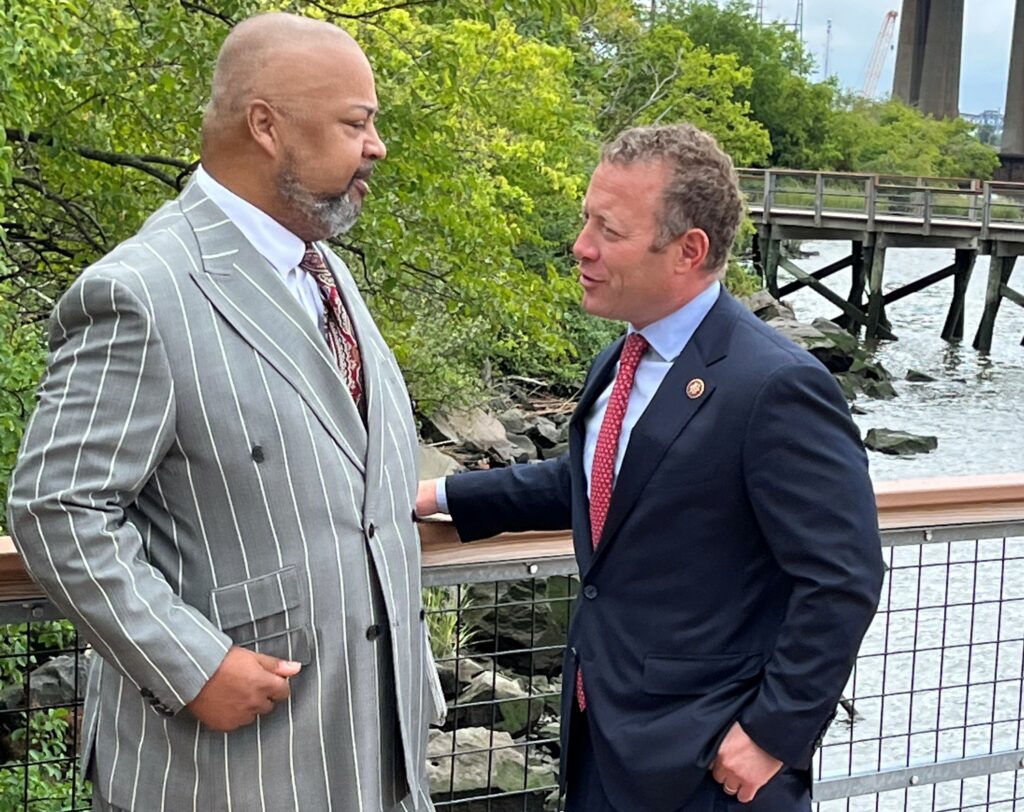In Battleground District, Gottheimer Sternly Nonpartisan

SECAUCUS - Even on an overcast morning, there's something comforting about standing alongside a flowing river - even the polluted Hackensack.
The pollution, of course, was the point of it all.
Reps. Josh Gottheimer and Donald Payne Jr. joined state and federal environmental officials today to trumpet the news that the lower half of the Hackensack is now on the nation's Superfund priorities list for clean-up.
That means the chemicals embedded on the river's bottom - a legacy of New Jersey's largely unregulated industrial past - will be removed and the river restored to how it was 100 or so years ago. The river flows from Oradell to Newark Bay and is a familiar sight to the thousands of Route 3 drivers who cross over it every day.
Similar federal projects are ongoing on the other main rivers of the region - the Hudson to the east and the Passaic to the west.
There's no mystery as to what happened.
The state was home to many manufacturing plants and other so-called "dirty" industries that in many ways helped build the country. But during a time when environmental regulations didn't exist, all types of industrial wastes ended up in the river. And that is where most of it has remained.
Gottheimer said dead fish periodically seen floating on the water's surface are a very visible sign of the problem.
But it's more than that.
Walter Mugdan, the EPA's Deputy Regional Administrator, and others explained how a polluted river leads to contaminated fish, some of which is consumed by birds, which puts them at risk, and also by humans.
"There is nothing partisan about cleaning up a river," said Gottheimer as he and others stood on a Boardwalk in the recently created Laurel Hill Park.
It's probably true that everyone likes clean water, but getting there certainly involves politics.
For example, it took the Murphy Administration to push the feds on the state's behalf to make cleaning up the Hackensack a priority. The Christie Administration had balked at the idea, officials said today.
Shawn M. LaTourette, the state DEP Commissioner, pinpointed the philosophical divide. He said some people think one must choose between a healthy environment and a healthy economy.
But that, he said, is a fallacy. You can have both and that's what guides the DEP.
Or as Payne observed, a bit more grandly, "We only have one earth. And we need to take care of it."
Still, there's also the matter of money.
Gottheimer credited the Infrastructure bill. which passed earlier this year, with providing $3.5 billion to the EPA's Superfund Remedial Program. This bill did get some Republican support.
But Gottheimer also mentioned the Inflation Reduction Act, which includes money to accelerate a move to clean energy. including tax rebates for the purchase of electric vehicles. That garnered no Republican support.
For the record, river pollution includes chemicals such as arsenic, lead, chromium and PCB's.
Mugdan of the EPA said the contamination is mostly in the muddy bottom of the river. Some of it will be dredged. What can not be removed will be covered, or "capped," with clean material to prevent its spread. The immediate next step for the Hackensack project is to develop a plan for exactly what has to be done.
This is not a quick or cheap project. It will cost billions and take years.
It makes you wonder what New Jersey politics will be like 20 years or so from now when the river is projected to be clean.





